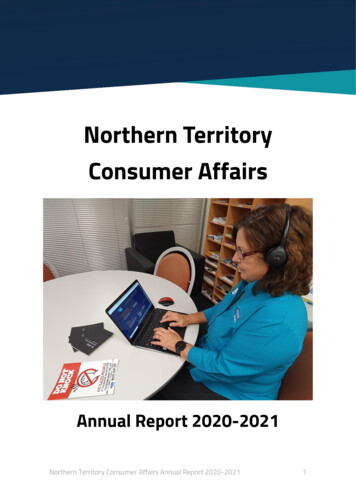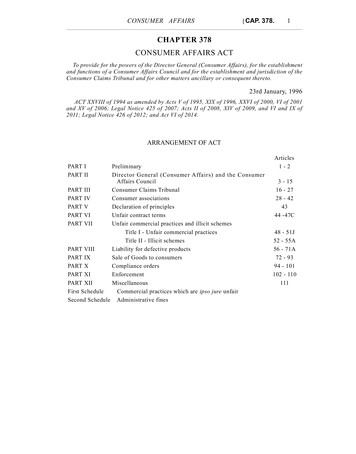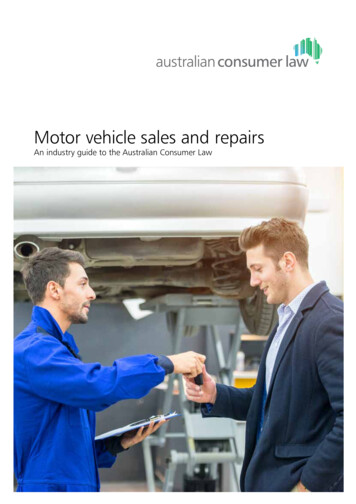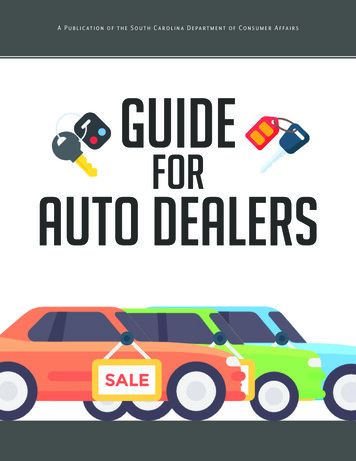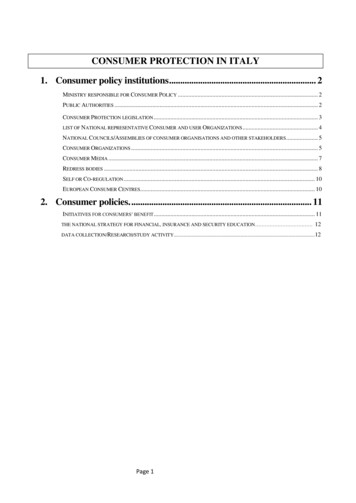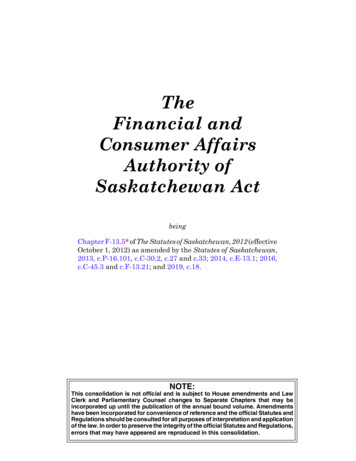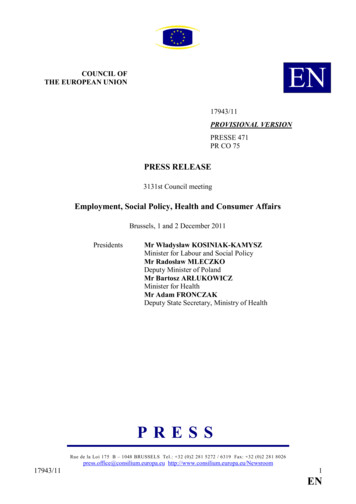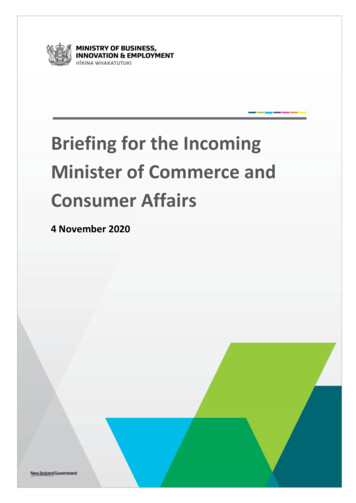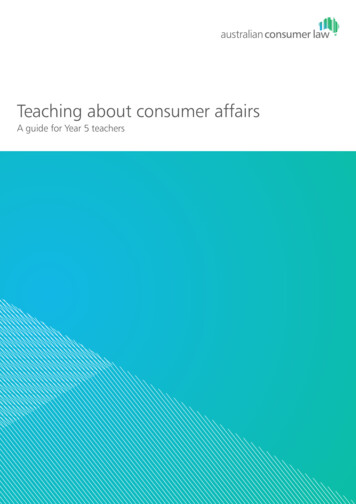
Transcription
Teaching about consumer affairsA guide for Year 5 teachers
This guide was developed by: Access Canberra, Australian Capital Territory Australian Competition and Consumer Commission Australian Securities and Investments Commission Consumer Affairs Victoria Consumer and Business Services South Australia Consumer, Building and Occupational Services, Tasmania New South Wales Fair Trading Northern Territory Consumer Affairs Queensland Office of Fair Trading Western Australia Department of Commerce, Consumer ProtectionISBN: 978 1 920702 08 3 Commonwealth of Australia 2017With the exception of the Australian Consumer Law logo, photographs and images, this publication is licensed under a Creative CommonsAttribution 3.0 Australia Licence.Creative Commons Attribution 3.0 Australia Licence is a standard form license agreement that allows you to copy, distribute, transmit andadapt this publication provided that you attribute the work. A summary of the licence terms is available from . The full licence terms are available from de.The Commonwealth’s preference is that you attribute this publication (and any material sourced from it) using the following wording:Source: Licensed from the Commonwealth of Australia under a Creative Commons Attribution 3.0 Australia Licence. The Commonwealthof Australia does not necessarily endorse the content of this publication.Inquiries regarding this licence and any other use of this document are welcome at:Manager Communications The Treasury Langton Crescent Parkes ACT 2600 Email: medialiaison@treasury.gov.au
IntroductionThis guide is an initiative of the Australian Consumer Law (ACL) regulators. The ACL is the national law for fair trading andconsumer protection. The ACL supports the goal of young people becoming smart consumers. Developing consumer andfinancial capability in young people is a strong investment in Australia’s social and economic future.Links between the resources andlearning areas/subjects of theAustralian CurriculumLinks between the resources and generalcapabilities of the Australian CurriculumLinks between the resources and thedimensions of the FrameworkAbout this guideThe Australian Curriculum andNational FrameworkLinks to the AustralianCurriculum and FrameworkThe Australian Curriculum and theNational Consumer and Financial LiteracyFramework have an important role insupporting young people to developconsumer and financial literacy. Thelearning areas and general capabilities inthe Australian Curriculum are designedto develop successful learners, confidentand creative individuals, and activeand informed citizens. The Frameworkprovides guidance on how consumer andfinancial education may be structuredacross the years of schooling in relationto the three dimensions of learningthat underpin consumer and financialeducation in the Australian context.The Consumer stuff for kids andBuy smart resources link with somelearning areas, general capabilities anddimensions of consumer and financialeducation more comprehensively thanothers. The diagrams above illustrate thestrength of these links.This guide provides advice to teachers onhow the following two resources align withthe Australian Curriculum and the NationalConsumer and Financial Literacy Framework(the Framework or National Framework):1. Consumer stuff for kids—developedby Consumer Affairs Victoria2. Buy smart—developed by the Officeof Fair Trading, Queensland.These resources contribute significantly tothe teaching and learning of consumerand financial literacy in Year 5. They havebeen designed flexibly so that schools andteachers can choose to teach one, moreor all units in each resource depending onthe needs of their students.Teachers can also use the AustralianCurriculum to make judgements aboutstudent achievement. Click here to seewhat students would be expected toknow, understand and do from havingbeen taught the units in each resource.
I am a consumerYear 5 Consumer stuff for kidsThis unit aims to introduce students to some fundamentaleconomic concepts such as their own role as consumers andthe difference between needs and wants.Content descriptionsHumanities and Social SciencesThe difference between needs and wants and why choicesneed to be made about how limited resources are used(ACHASSK119)Locate and collect relevant information and data from primaryand secondary sources (ACHASSI095)Work in groups to generate responses to issues and challenges(ACHASSI102)Use criteria to make decisions and judgements and consideradvantages and disadvantages of preferring one decision overothers (ACHASSI103)General capabilitiesLiteracyLevel 4: Typically, by the end of Year 6, students can: listen to detailed spoken instructions for undertakinglearning tasks, listen to spoken and audio texts, andrespond to and interpret information and opinionspresented use pair, group and class discussions and informal debatesas learning tools to explore ideas and relationships, testpossibilities, compare solutions and to prepare for creatingtextsCritical and creative thinkingLevel 4: Typically, by the end of Year 6, students can: identify and justify the thinking behind choices theyhave madeEnglishNational FrameworkClarify understanding of content as it unfolds in formaland informal situations, connecting ideas to students’own experiences and present and justify a point of view(ACELY1699)CompetenceUse interaction skills, for example paraphrasing, questioningand interpreting non-verbal cues and choose vocabulary andvocal effects appropriate for different audiences and purposes(ACELY1796)By the end of Year 6, students can: evaluate the value of a range of goods and services in avariety of ‘real-life’ situationsResponsibility and enterpriseBy the end of Year 6, students can: exercise a range of enterprising behaviours throughparticipation in relevant class and/or school activities recognise that satisfaction derived from spending moneyvaries according to the nature of the purchase, thecontext in which it is bought and an individual’s personalcircumstances and values4
An informed consumerYear 5 Consumer stuff for kidsThis unit introduces students to their basic rights andresponsibilities as consumers. Ways to deal with commonproblems, such as how to make a complaint and how toidentify common scams and ways to avoid them are explored.Plan, draft and publish imaginative, informative and persuasiveprint and multimodal texts, choosing text structures, languagefeatures, images and sound appropriate to purpose andaudience (ACELY1704)Content descriptionsRe-read and edit student’s own and others’ work using agreedcriteria for text structures and language features (ACELY1705)Humanities and Social SciencesGeneral capabilitiesInfluences on consumer choices and methods that can beused to help make informed personal consumer and financialchoices (ACHASSK121)LiteracyDevelop appropriate questions to guide an inquiry aboutpeople, events, developments, places, systems and challenges(ACHASSI094)Work in groups to generate responses to issues and challenges(ACHASSI102)Use criteria to make decisions and judgements and consideradvantages and disadvantages of preferring one decision overothers (ACHASSI103)Reflect on learning to propose personal and/or collectiveaction in response to an issue or challenge, and predict theprobable effects (ACHASSI104)Level 4: Typically, by the end of Year 6, students can: compose and edit learning area texts use pair, group and class discussions and informal debatesas learning tools to explore ideas and relationships,test possibilities, compare solutions and to prepare forcreating texts use developing knowledge of the structure and featuresof learning area texts to comprehend and compose arange of more complex texts for identified purposes use subjective, objective and evaluative language, andidentify biasPersonal and social capabilityPresent ideas, findings, viewpoints and conclusions in a rangeof texts and modes that incorporate source materials, digitaland non-digital representations and discipline-specific termsand conventions (ACHASSI105)Level 4: Typically, by the end of Year 6, students can: identify and explain factors that influence effectivecommunication in a variety of situationsEnglishEthical understandingUnderstand that patterns of language interaction vary acrosssocial contexts and types of texts and that they help to signalsocial roles and relationships (ACELA1501)Level 4: Typically, by the end of Year 6, students can: examine and explain ethical concepts such as truthand justice that contribute to the achievement of aparticular outcomeClarify understanding of content as it unfolds in formaland informal situations, connecting ideas to students’own experiences and present and justify a point of view(ACELY1699)Use interaction skills, for example paraphrasing, questioningand interpreting non-verbal cues and choose vocabulary andvocal effects appropriate for different audiences and purposes(ACELY1796)Identify and explain characteristic text structures and languagefeatures used in imaginative, informative and persuasive textsto meet the purpose of the text (ACELY1701)5
National FrameworkKnowledge and understandingBy the end of Year 6, students can: identify and discuss some rights and responsibilities ofconsumers and businessCompetenceBy the end of Year 6, students can: identify key features used in advertising, marketing andsocial media to influence consumer decision-makingResponsibility and enterpriseBy the end of Year 6, students can: examine and discuss the external factors that influenceconsumer choices explain there are ethical considerations to some consumerand financial decisions apply consumer and financial knowledge and skills inrelevant class and/or school activities such as studentinvestigations, charity fundraising, product design anddevelopment, business ventures and special events exercise a range of enterprising behaviours throughparticipation in relevant class and/or school activities6
Let’s workYear 5 Consumer stuff for kidsThis unit introduces students to the role of work in society,the differences between paid and unpaid work and the rangeof occupations that exist. Students are also asked to considertheir preferred job and why the job appeals to them.Content descriptionsNational FrameworkKnowledge and understandingBy the end of Year 6, students can: describe how an individual can influence their income explore the value of unpaid work to the communityHumanities and Social SciencesUse criteria to make decisions and judgements and consideradvantages and disadvantages of preferring one decision overothers (ACHASSI103)EnglishClarify understanding of content as it unfolds in formaland informal situations, connecting ideas to students’own experiences and present and justify a point of view(ACELY1699)Use interaction skills, for example paraphrasing, questioningand interpreting non-verbal cues and choose vocabulary andvocal effects appropriate for different audiences and purposes(ACELY1796)Plan, draft and publish imaginative, informative and persuasiveprint and multimodal texts, choosing text structures, languagefeatures, images and sound appropriate to purpose andaudience (ACELY1704)General capabilitiesLiteracyLevel 4: Typically, by the end of Year 6, students can: compose and edit learning area texts use pair, group and class discussions and informal debatesas learning tools to explore ideas and relationships,test possibilities, compare solutions and to prepare forcreating textsCritical and creative thinkingLevel 4: Typically, by the end of Year 6, students can: identify and justify the thinking behind choices theyhave made7
Money, money, moneyYear 5 Consumer stuff for kidsThis unit introduces students to the basic features of themonetary system such as the services provided by banks, therole of banking, budgeting and saving and the different waysto pay for goods and services. The concept of opportunitycost and the importance of personal money management arealso explored.Content descriptionsHumanities and Social SciencesBy the end of Year 5, students will be taught: the difference between needs and wants and why choicesneed to be made about how limited resources are used(ACHASSK119) influences on consumer choices and methods that canbe used to help make informed personal consumer andfinancial choices (ACHASSK121) to locate and collect relevant information and data fromprimary and secondary sources (ACHASSI095) to use criteria to make decisions and judgements andconsider advantages and disadvantages of preferring onedecision over others (ACHASSI103)MathematicsBy the end of Year 5, students will be taught to: use efficient mental and written strategies and applyappropriate digital technologies to solve problems(ACMNA291) create simple financial plans (ACMNA106)Visual ArtsBy the end of Year 6, students will be taught to: develop and apply techniques and processes whenmaking their artworks (ACAVAM115)General capabilitiesLiteracyLevel 4: Typically, by the end of Year 6, students: navigate, read and view subject-specific textswith some challenging features and a range ofgraphic representations compose and edit learning area textsEnglishNumeracyBy the end of Year 5, students will be taught to: clarify understanding of content as it unfolds in formaland informal situations, connecting ideas to students’own experiences and present and justify a point of view(ACELY1699) use interaction skills, for example paraphrasing,questioning and interpreting non-verbal cues and choosevocabulary and vocal effects appropriate for differentaudiences and purposes (ACELY1796) plan, draft and publish imaginative, informative andpersuasive print and multimodal texts, choosing textstructures, language features, images and soundappropriate to purpose and audience (ACELY1704) create literary texts using realistic and fantasy settings andcharacters that draw on the worlds represented in textsstudents have experienced (ACELT1612) re-read and edit student’s own and others’ work usingagreed criteria for text structures and language features(ACELY1705)Level 4: Typically, by the end of Year 6, students can: solve problems and check calculations using efficientmental and written strategies create simple financial plans, budgets and cost predictionsInformation and communication technologyLevel 4: Typically, by the end of Year 6, students can: locate, retrieve or generate information using searchengines and simple search functions and classifyinformation in meaningful waysCritical and creative thinkingLevel 4: Typically, by the end of Year 6, students can: identify and justify the thinking behind choices theyhave made8
National FrameworkKnowledge and understandingBy the end of Year 6, students can: explain how financial transactions can include using morethan notes and coins describe how an individual can influence their income recognise that families use household income to meetregular financial commitments and immediate andfuture expenses explain how money can be borrowed to meet needs andwants and that there may be a cost involvedCompetenceBy the end of Year 6, students can: create simple budgets for a range of purposes and explainthe benefits of saving for future needs and wants order and justify reasons for spending preferences evaluate the value of a range of goods and services in avariety of ‘real-life’ situations discuss various payment options for purchasing goods andservices such as: cash, debit card, credit card, direct debitand PayPalResponsibility and enterpriseBy the end of Year 6, students can: explain there are ethical considerations to some consumerand financial decisions exercise a range of enterprising behaviours throughparticipation in relevant class and/or school activities9
What is an economy?Year 5 Consumer stuff for kidsThis unit aims to explain market forces to students so theyunderstand how markets work, the role of consumers andproducers in the market and the differences between natural,human and capital resources.Personal and social capabilityContent descriptionsCritical and creative thinkingHumanities and Social SciencesLevel 4: Typically, by the end of Year 6, students can: identify and justify the thinking behind choices theyhave madeThe difference between needs and wants and why choicesneed to be made about how limited resources are used(ACHASSK119)Types of resources (natural, human, capital) and the wayssocieties use them to satisfy the needs and wants of presentand future generations (ACHASSK120)Use criteria to make decisions and judgements and consideradvantages and disadvantages of preferring one decision overothers (ACHASSI103)EnglishClarify understanding of content as it unfolds in formaland informal situations, connecting ideas to students’own experiences and present and justify a point of view(ACELY1699)Use interaction skills, for example paraphrasing, questioningand interpreting non-verbal cues and choose vocabulary andvocal effects appropriate for different audiences and purposes(ACELY1796)Level 4: Typically, by the end of Year 6, students can: identify causes and effects of conflict, and practisedifferent strategies to diffuse or resolve conflict situationsNational FrameworkCompetenceBy the end of Year 6, students can: evaluate the value of a range of goods and services in avariety of ‘real-life’ situations order and justify reasons for spending preferencesResponsibility and enterpriseBy the end of Year 6, students can: exercise a range of enterprising behaviours throughparticipation in relevant class and/or school activitiesGeneral capabilitiesLiteracyLevel 4: Typically, by the end of Year 6, students can: navigate, read and view subject-specific textswith some challenging features and a range ofgraphic representations use vocabulary, including subject-specific vocabulary froma range of learning areas and vocabulary that expressesshades of meaning10
Consuming planet earthYear 5 Consumer stuff for kidsThis unit introduces the concept of sustainable consumptionand enables students to understand their own role asproducers and consumers and the importance of beinginformed when making decisions.Content descriptions negotiate criteria for success that include sustainabilityto evaluate design ideas, processes and solutions(ACTDEP027)develop project plans that include consideration ofresources when making designed solutions individuallyand collaboratively (ACTDEP028)Humanities and Social SciencesGeneral capabilitiesBy the end of Year 5, students will be taugh: the types of resources (natural, human, capital) and theways societies use them in order to satisfy the needs andwants of present and future generations (ACHASSK120) the influences on consumer choices and methods that canbe used to help make informed personal consumer andfinancial choices (ACHASSK121) to evaluate evidence to draw conclusions (ACHASSI101) to reflect on learning to propose personal and/orcollective action in response to an issue or challenge, andpredict the probable effects (ACHASSI104)LiteracyEnglishBy the end of Year 5, students will be taught to: use interaction skills, for example paraphrasing,questioning and interpreting non-verbal cues and choosevocabulary and vocal effects appropriate for differentaudiences and purposes (ACELY1796) plan, draft and publish imaginative, informative andpersuasive print and multimodal texts, choosing textstructures, language features, images and soundappropriate to purpose and audience (ACELY1704)ScienceBy the end of Year 5, students will be taught: how scientific knowledge is used to solve problems andinform personal and community decisions (ACSHE083)Level 4: Typically, by the end of Year 6, students can: use pair, group and class discussions and informal debatesas learning tools to explore ideas and relationships,test possibilities, compare solutions and to prepare forcreating texts compose and edit learning area textsCritical and creative thinkingLevel 4: Typically, by the end of Year 6, students can: pose questions to clarify and interpret information andprobe for causes and consequences identify and clarify relevant information andprioritise ideas assess and test options to identify the most effectivesolution and to put ideas into action identify and justify the thinking behind choices theyhave madeEthical understandingLevel 4: Typically, by the end of Year 6, students can: evaluate the consequences of actions in familiar andhypothetical scenariosDesign and TechnologiesBy the end of Year 6, students will be taught to: select appropriate materials, components, tools,equipment and techniques and apply safe procedures tomake designed solutions (ACTDEP026)11
National FrameworkResponsibility and enterpriseBy the end of Year 6, students can: identify and describe the impact that the consumerdecisions of individuals may have on themselves and theirfamilies, the broader community and/or the environment apply consumer and financial knowledge and skills inrelevant class and/or school activities such as studentinvestigations, charity fundraising, product design anddevelopment, business ventures and special events exercise a range of enterprising behaviours throughparticipation in relevant class and/or school activities12
It’s your choiceYear 5 Consumer stuff for kidsThis unit aims to develop students’ personal and socialcapability, such as resilience, feelings of self-worth, settinggoals, and predicting consequences, so that they understandthat inappropriate social behaviour can be linked to feelings oflow self-esteem and over dependence on peer actions and arebetter equipped to make informed decisions in areas such asconsumer purchases.Content descriptionsHumanities and Social SciencesBy the end of Year 5, students will be taught: the influences on consumer choices and methods that canbe used to help make informed personal consumer andfinancial choices (ACHASSK121) to evaluate evidence to draw conclusions (ACHASSI101) to work in groups to generate responses to issues andchallenges (ACHASSI102) to use criteria to make decisions and judgements andconsider advantages and disadvantages of preferring onedecision over others (ACHASSI103) to reflect on learning to propose personal and/orcollective action in response to an issue or challenge, andpredict the probable effects (ACHASSI104)EnglishBy the end of Year 5, students will be taught to: clarify understanding of content as it unfolds in formaland informal situations, connecting ideas to students’own experiences and present and justify a point of view(ACELY1699) use interaction skills, for example paraphrasing,questioning and interpreting non-verbal cues and choosevocabulary and vocal effects appropriate for differentaudiences and purposes (ACELY1796)Health and Physical EducationBy the end of Year 6, students will be taught to: examine how identities are influenced by people andplaces (ACPPS051) investigate community resources and ways to seek helpabout health, safety and wellbeing (ACPPS053) practise skills to establish and manage relationships(ACPPS055) examine the influence of emotional responses onbehaviour and relationships (ACPPS056)General capabilitiesLiteracyLevel 4: Typically, by the end of Year 6, students can: use pair, group and class discussions and informal debatesas learning tools to explore ideas and relationships,test possibilities, compare solutions and to prepare forcreating textsInformation and communication technologyLevel 4: Typically, by the end of Year 6, students can: use ICT effectively to record ideas, represent thinking andplan solutionsCritical and creative thinkingLevel 4: Typically, by the end of Year 6, students can: pose questions to clarify and interpret information andprobe for causes and consequences identify and clarify relevant information and prioritiseideas assess and test options to identify the most effectivesolution and to put ideas into action identify and justify the thinking behind choices theyhave made13
Personal and social capabilityLevel 4: Typically, by the end of Year 6, students can: describe the influence that personal qualities andstrengths have on their learning outcomes monitor their progress, seeking and responding tofeedback from teachers to assist them in consolidatingstrengths, addressing weaknesses and fulfillingtheir potential explain the influence of emotions on behaviour, learningand relationships analyse factors that influence ability to self-regulate;devise and apply strategies to monitor own behaviour andset realistic learning goals devise strategies and formulate plans to assist in thecompletion of challenging tasks and the maintenance ofpersonal safety contribute to groups and teams, suggestingimprovements in methods used for group investigationsand projects identify factors that influence decision making andconsider the usefulness of these in making theirown decisions identify causes and effects of conflict, and practisedifferent strategies to diffuse or resolve conflict situationsEthical understandingLevel 4: Typically, by the end of Year 6, students can: evaluate the consequences of actions in familiar andhypothetical scenariosIntercultural understandingLevel 4: Typically, by the end of Year 6, students can: explain perspectives that differ to expand theirunderstanding of an issue imagine and describe the situations of others in local,national and global contextsNational FrameworkResponsibility and enterpriseBy the end of Year 6, students can: identify and describe the impact that the consumerdecisions of individuals may have on themselves and theirfamilies, the broader community and/or the environment exercise a range of enterprising behaviours throughparticipation in relevant class and/or school activities14
How can we make money?Year 5 Consumer stuff for kidsThis unit enables students to apply their knowledge andunderstanding of consumer and financial matters to the reallife context of planning, delivering and evaluating a fundraising activity. In applying this knowledge and understanding,students also consider how business and charity organisationsgenerate funds.Content descriptionsHumanities and Social SciencesBy the end of Year 5, students will be taught to: develop appropriate questions to guide an inquiry aboutpeople, events, developments, places, systems andchallenges (ACHASSI094) locate and collect relevant information and data fromprimary and secondary sources (ACHASSI095) organise and represent data in a range of formatsincluding tables, graphs and large- and small-scale maps,using discipline-appropriate conventions (ACHASSI096) examine different viewpoints on actions, events, issuesand phenomena in the past and present (ACHASSI099) interpret data and information displayed in a range offormats to identify, describe and compare distributions,patterns and trends, and to infer relationships(ACHASSI100) evaluate evidence to draw conclusions (ACHASSI101) work in groups to generate responses to issues andchallenges (ACHASSI102) use criteria to make decisions and judgements andconsider advantages and disadvantages of preferring onedecision over others (ACHASSI103) reflect on learning to propose personal and/or collectiveaction in response to an issue or challenge, and predictthe probable effects (ACHASSI104)EnglishBy the end of Year 5, students will be taught to: use interaction skills, for example paraphrasing,questioning and interpreting non-verbal cues and choosevocabulary and vocal effects appropriate for differentaudiences and purposes (ACELY1796) plan, rehearse and deliver presentations for definedaudiences and purposes incorporating accurate andsequenced content and multimodal elements (ACELY1700) plan, draft and publish imaginative, informative andpersuasive print and multimodal texts, choosing textstructures, language features, images and soundappropriate to purpose and audience (ACELY1704)MathematicsBy the end of Year 5, students will be taught to: use efficient mental and written strategies and applyappropriate digital technologies to solve problems(ACMNA291) create simple financial plans (ACMNA106) pose questions and collect categorical or numerical databy observation or survey (ACMSP118) construct displays, including column graphs, dot plots andtables, appropriate for data type, with and without theuse of digital technologies (ACMSP119) describe and interpret different data sets in context(ACMSP120)Digital technologiesBy the end of Year 6, students will be taught to: acquire, store and validate different types of data, anduse a range of software to interpret and visualise data tocreate information (ACTDIP016)15
General capabilitiesPersonal and social capabilityLiteracyLevel 4: Typically, by the end of Year 6, students can: identify a community need or problem and consider waysto take action to address itLevel 4: Typically, by the end of Year 6, students can: compose and edit learning area texts use pair, group and class discussions and informal debatesas learning tools to explore ideas and relationships, testpossibilities, compare solutions and to prepare for creatingtexts plan, research, rehearse and deliver presentations onlearning area topics, selecting appropriate content andvisual and multimodal elements to suit different audiencesNational FrameworkCompetenceBy the end of Year 6, students can: use a range of methods and tools to keep financial recordsin ‘real-life’ contextsNumeracyResponsibility and enterpriseLevel 4: Typically, by the end of Year 6, students can: solve problems and check calculations using efficientmental and written strategies create simple financial plans, budgets and cost predictions collect, compare, describe and interpret data as 2-waytables, double column graphs and se
Consumer and Financial Literacy Framework (the Framework or National Framework): 1. Consumer stuff for kids—developed by Consumer Affairs Victoria 2. Buy smart—developed by the Office of Fair Trading, Queensland. These resources contribute significantly to the teaching and learning of consumer and financial literacy in Year 5. They have
